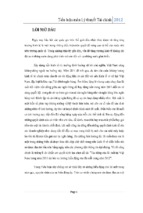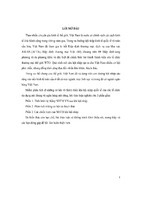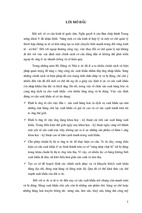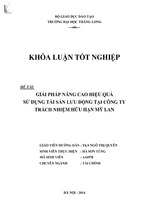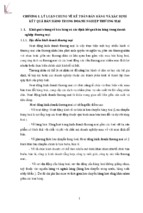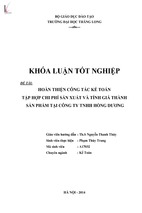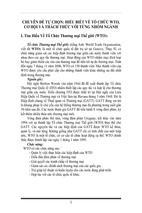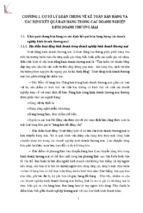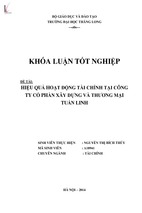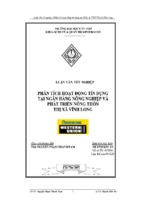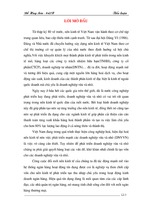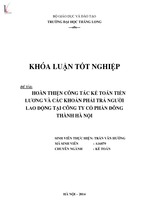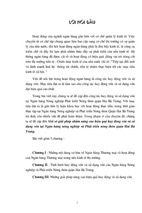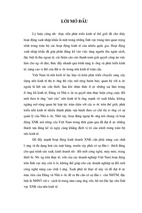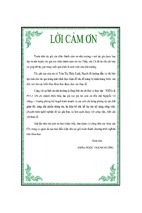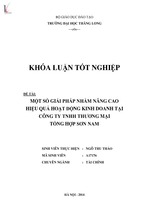Mô tả:
Table of Contents
Preface 3
Chapter I: Overview of audit documentation and working papers in auditing financial statements 4
1 The concept of financial audit. 4
1.1 Nature of audit 4
1.1.1 The demand for reliable information 4
1.1.2 Reducing information risk and the rise of audit. 5
1.2 Audit Definition 5
2 Overview of audit documentation and working papers in auditing financial statements 6
2.1 Audit documentation 6
2.1.1 Audit documentation definition 6
2.1.2 Types of Audit documentations 7
2.1.3 The role and meaning of audit documentation 8
2.2 Working papers 8
2.2.1 Working papers definition 8
2.2.1.1. What are working papers: 8
2.2.1.2 Reason in preparing working papers: 9
2.2.2 Content of Audit working papers. 11
2.2.3 Importance of working papers 14
2.2.3.1 Importance of Working papers 15
2.2.4 Review of working paper 15
2.2.4.1 Review of working paper 15
2.2.4.2 Checking the working papers: 16
2.2.4.3 Confidentiality of working papers. 16
Chapter 2: Current situations of designing audit procedures in auditing the financial statements of listed companies implemented by AAC Auditing and Accounting Co., Ltd 17
1 Overview of AAC Auditing and Accounting Co., Ltd 17
1.1 Establishment and development history 17
Organizational Structure of AAC 19
2. Reality the organization of working papers system at AAC Company 21
2.1 An overview about the reality on the AAC’s working papers 21
2.1.1 Regulations on working papers in AAC 21
2.1.1.1. Form of working papers 21
2.1.1.2. The general form of standard working papers at the company AAC 21
2.1.1.3. Symbol used 22
2.1.1.4 Typing reference on paper work 25
2.1.1.5. Linking working paper 26
2.1.1.6. Principle in review working paper of AAC 26
2.2.1 Sets of working paper account cash and equivalen cash 29
Chapter III. SOME REMARKS AND PROPOSALS FOR ESTABLISHING WORKING PAPERS LIBRARY OF COMPANY ACCOUNTING AND AUDIT AAC. 32
3.1 Advantages and disadvantages of current working paper 32
3.1.1 Advantages 32
3.1.2 Disadvantages 33
3.2 Recommendations in order to improve working papers libraries AAC Company 33
3.2.1 Completing the design unfinished procedure in the paper work 34
3.2.1.1 Account cash an equivalent cash 34
3.2.1.2 Account receivables. 34
3.2.1.3 Account payable 35
*Adjusting the Balance per Bank 37
*Adjusting the Balance per Books 38
Conclusion 50
REFERENCES 50
Preface
Today, audit working paper is not the strange terminology with the economists because of their important role for the audit. Building is a complete working paper systems which can be used for any company is a huge target for any public audit Company. As the fact that, in 2014, AAC Audit Company has a changing in working paper system for the new one, I think I should do a small development program one hand learning about the importance of the audit working papers system and inn the other hand contribute a small part of completing the AAC working system. With the limited content, I will divide my article into 3 chapters
+CHAPTER 1: Overview of audit documentation and working papers in auditing financial statements
+CHAPTER 2: Current situations of designing audit procedures in auditing the financial statements of listed companies implemented by AAC Auditing and Accounting Co., Ltd
+Chapter 3:+ SOME REMARKS AND PROPOSALS FOR ESTABLISHING WORKING PAPERS LIBRARY OF COMPANY ACCOUNTING AND AUDIT AAC
Chapter I: Overview of audit documentation and working papers in auditing financial statements
1 The concept of financial audit.
1.1 Nature of audit
1.1.1 The demand for reliable information
As society becomes more complex, decision makers are more likely to face with the information risk which lead the investors may make wrong decisions for their investments. After scandal of Sabena Oxley, information risk becomes an emerging issue which is concerned by all economists in the world.
According to “Audit and assurance services”, the information risk is: the probability that the information circulated by a company will be false or misleading. Client management has an incentive to make the business appear better than it actually may be. This can create a conflict of interest between client management and investors.
There are several reasons for information risk: remoteness of information, biases and motives of the provider, voluminous data, and the existence of complex exchange transactions.
Remoteness of Information: In a global economy, it is nearly impossible for a decision maker to have much knowledge about the organization with which they do business because decisions makers are not trained to collect, compile, and summarize the key operating information themselves. They need to rely on the others which can cause to intentionally or unintentionally misstated increases.
Biases and Motives of the Provider: If information is provided by someone whose goals are inconsistent with those of the decision maker, the information may be biased in favor of the provider.
Voluminous Data: organizations become larger accompanied by the volume of their exchange transactions. This increases the likelihood that improperly recorded information is included in the records perhaps hidden in a large amount of other information. If many minor misstatements remain undiscovered, the combined total can be significant.
Complex Exchange Transactions: In the past few decades, exchange transactions between organizations have become increasingly complex and therefore more difficult to record properly. For example, the correct accounting treatment of the acquisition of one entity by another poses relatively difficult accounting problems. Other examples include properly combining and disclosing the results of operations of subsidiaries in different industries and properly disclosing derivative financial instruments.
1.1.2 Reducing information risk and the rise of audit.
After comparing costs and benefits, business managers and financial statement users may conclude that the best way to deal with information risk is simply to have it remain reasonably high. A small company may find it less expensive to pay higher interest costs than to increase the costs of reducing information risk.
For larger businesses, it is usually practical to incur costs to reduce information risk. There are three main ways to do so.
User Verifies Information: The user may go to the business premises to examine records and obtain information about the reliability of the statements. Normally, this is impractical because of cost. In addition, it is economically inefficient for all users to verify the information individually.
There are some users can perform their own verification such as the tax department do this to reflect the actual tax due the government or the company use auditors to verify and evaluate the information of potential child company in the business acquisitions purpose.
User Shares Information Risk with Management: There is considerable legal precedent indicating that management is responsible for providing reliable information to users. If users rely on inaccurate financial statements and as a result incur a financial loss, they may have a basis for a lawsuit against management. A difficulty with sharing information risk with management is that users may not be able to collect on losses. If a company is unable to repay a loan because of bankruptcy, it is unlikely that management will have sufficient funds to repay users.
Audited Financial Statements Are Provided: The most common way for users to obtain reliable information is to have an independent audit. Typically, management of a private company or the audit committee for a public company engages the auditor to provide assurances to users that the financial statements are reliable.
Decision makers can then use the audited information on the assumption that it is reasonably complete, accurate, and unbiased. The auditor work is valuable because of the auditor’s independence from the client and knowledge of financial statement reporting matters, and their checking expertise. This way is the most common way to reduce the information risk and that is economics demand for auditing.
1.2 Audit Definition
According to auditing and assurance services fifth edition: Auditing is a systematic process of objectively obtaining and evaluating evidence regarding assertions about economic actions and events to ascertain the degree of correspondence between the assertions and established criteria and communicating the results to interested users.
Financial audit is a typical activity of the audit, with the specific objective is "to express an opinion confirming that the financial statements have been prepared on the basis of standards and current accounting regulations (or be acceptance), with related legal compliance, there give a true and fair view, in all material respects or not
Audit Assertions are the implicit or explicit claims and representations made by the management responsible for the preparation of financial statements regarding the appropriateness of the various elements of financial statements and disclosures. The financial audit assertions are about the trueness and fairness of the financial statement (include the footnotes statement)
The established criteria is the common set of accounting principles, standards and procedures that companies use to compile their financial statements. GAAP are a combination of authoritative standards (set by policy boards) and simply the commonly accepted ways of recording and reporting accounting information.
An external user is a person outside of an organization who does not directly run its operations and uses financial or accounting information about that company to make decisions. In other words, it’s someone who doesn’t manage or work for a company but uses its financial information. The common external user is investors, creditors and banks.
2 Overview of audit documentation and working papers in auditing financial statements
2.1 Audit documentation
2.1.1 Audit documentation definition
With any audits, Evidence is obtained by the auditor to determine whether the information being audited is stated in accordance with the established criteria. To satisfy the purpose of the audit, auditors must obtain a sufficient quality and volume of evidence. Auditors must determine the types and amount of evidence necessary and evaluate whether the information corresponds to the established criteria. The auditors need to storage this evidence and all the work they had done in the audit documentation for audit purpose.
According to the Auditing Standards Number 230 Issued under Decision No 120/1999 / QD-BTC of September 27, 1999 of the Ministry of Finance stated: Audit records are documents auditors established, collected, sorted, used and storage stored in a certain order as evidence for one specific audit. Documents in the Audit documentation is shown on paper, on film, photographs, informatics media or any other storage media in accordance with current law
2.1.2 Types of Audit documentations
According to VSA 230, the audit documentation divided should be prepared and arranged into: permanent audit documentation and current audit documentation
2.1.2.1 . Permanent Audit documentation
VSA 230 defines general audit documentation as follows: Permanent audit files is record contains general information about the client involves two or more audits during the financial years of a client.
This files stored documents, schedules and other historical or continuous information needed for many years. This profile provides a suitable source of information about the client, service of current and future audits if contracts continue.
Continually updated information is also a problem should be noted with this file. Permanent audit documentation is the useful tool for the audit. In some specific case, Auditors only focus on complete the current audit documentation and they don’t review and update the information of permanent audit files. This may lead to the reducing of quality of this information because the information in it has become outdated and often not usable anymore, leading to influence audit quality.
Thus, the examination and update documents in permanent audit files on a regular basis are essential. Auditors should add new information and adjust old information when client’s Company information has changed and they must specify the changes in this file.
2.1.2.2 Curret audit documentation
VSA 230 has defined Current audit file as follows: "current audit documentation is the file contain customer information relates only to audits of financial year”
Annual audit records include documents provided by the customer, such as financial documents, accounting, taxes, of state agencies and superiors concerning the financial year; The minutes confirmed by stakeholders sent to. Besides, it include the documents of auditor; Notes on content, program and scope of the audit procedures performed and the results obtained; The audit report, management letter and other reports; The correspondence with other auditors, experts and other stakeholders;…
2.1.3 The role and meaning of audit documentation
Audit documentation has collected all information relevant to their audit clients to serve their audit work as:
+ Storing the evidence collected by performed auditor as basis for an opinion of auditors:
The information about the customer as well as the object audit fully updated and supplemented continuously throughout the audit process to ensure adequate basis for forming auditors audit opinion. This evidence obtained ensure the opinions of auditor are base on the reliable, quality assurance of audit
+ Help for planning and performing the audit.
Normally, an audit is taking place by two or three auditors above in the certain time period. They need audit plan to divide work and forming structure of the entitle audit to conduct the audit efficiently. To get a appropriate plan for the current year, the auditor must consult the information about the client (with the new client) and refer the previous audit documentation (with the old one).
+ Help for inspection, review and evaluate the quality of the audit:
All documents, information and evidence collected are storing in the audit documentation. Chief audit team checked the working paper and request explanations of subordinates before giving up a higher level for approval. This is the basis for the inspectors to understand the entire contents of the audit as well as oversight the work of subordinate thus it also increases the quality of audit.
+ Help for the treatment of arising after the audit:
The occurrence of conflicts and litigation, as well as quality test of Association practice and the Ministry of Finance is inevitable. Then audit documentation is important legal evidence help auditors solve the problems that arise after the audit. It can prove that audit was planned well, fully supervised, progress operating in accordance with auditing standards. With audit evidence collected valuable, complete, timely and audit reports were correct evaluation of audit results, audit file would minimize audit risk may occur. On the other hand the audit files also the information that helpful for future audits.
2.2 Working papers
2.2.1 Working papers definition
2.2.1.1. What are working papers:
“Working papers “are the written record of the basis for the auditor's conclusions that provides the support for the auditor's representations, whether those representations are contained in the auditor's report or otherwise. Audit working papers also facilitates the planning, performance, and supervision of the engagement, and is the basis for the review of the quality of the work because it provides the reviewer with written documentation of the evidence supporting the auditor's significant conclusions. Among other things, working papers include records of the planning and performance of the work, the procedures performed, evidence obtained, and conclusions reached by the auditor.
It may be in the form of data stored on the paper, film, electronic media, or other media. They can also be used in court e.g. in case of negligent audit.
Working papers are reviewed by members of the engagement team performing the work and might be reviewed by others for different purposes. Reviewers might include, for example:
+ Auditors who are new to an engagement and review the prior year's documentation to understand the work performed as an aid in planning and performing the current engagement.
+ Supervisory personnel who review documentation prepared by other members of the engagement team.
+ Engagement supervisors and engagement quality reviewers who review documentation to understand how the engagement team reached significant conclusions and whether there is adequate evidential support for those conclusions.
+A successor auditor who reviews a predecessor auditor's audit documentation.
+ Internal and external inspection teams that review documentation to assess audit quality and compliance with auditing and related professional practice standards; applicable laws, rules, and regulations; and the auditor's own quality control policies.
+ Others, including advisors engaged by the audit committee or representatives of a party to an acquisition
2.2.1.2 Reason in preparing working papers:
+ This is basis for planning the audit.
+ Working papers record the evidence accumulated and the results of the audit tests
+ Working papers have data for determining the proper type of audit report
+ Basis for review by supervisors and partners
+ Evidence audit works being performed in accordance with approved auditing standards.
2.2.1.3 Purpose of audit working paper
Working papers are the evidence of work done by the auditor, he should prepare working paper in order to provide evidence that audit was properly performed according to ISA Standards. Working papers support auditor, in case he is being sue in court by the client, for negligence of audit work.
+ Assist in the planning and performance of the audit
+ Assist in the supervision and review of audit work
+ Recorded the audit evidence resulting from the audit work performed to support the auditor’s opinion

